2018 How Much Credit Card Debt Do.most Families Carry
Average American Credit Card Debt in 2021: $5,525
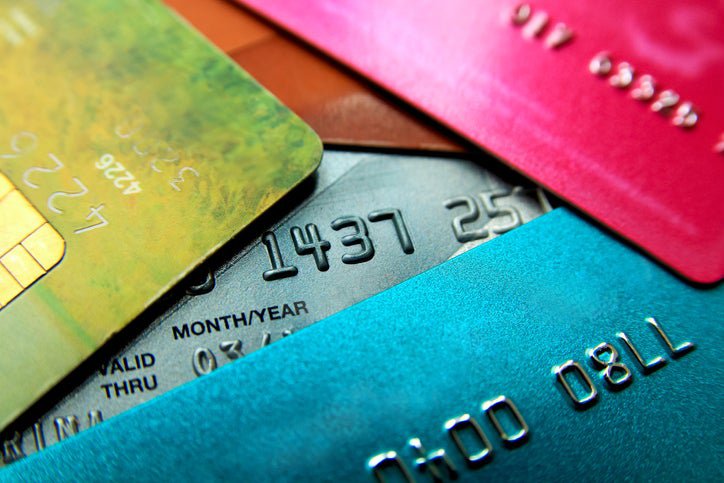
Image source: Getty Images
According to the well-nigh recent research, the average American credit card debt is $5,525. The average card balance has decreased by $968 from where it was before the COVID-xix pandemic, and the total U.South. credit card debt has also gone downwardly to $787 billion.
While those are the overall numbers, they vary significantly for different demographics. We've reviewed data from regime agencies and credit bureaus to detect the average credit card debt by land, age, income, and much more than. Keep reading for the full results.
Key findings
- Average American credit bill of fare debt: $5,525
- Average credit utilization rate: 25.two%
- Land with the highest average credit card debt: Alaska ($seven,089)
- State with the lowest average credit card debt: Wisconsin ($4,587)
- Generation X has average credit card debt of $seven,236, the most of any generation.
- College income corresponds to higher average credit carte du jour balances, merely consumers in the eye income brackets are the most likely to have credit card debt.
- Credit card interest rates have been rising, and the average rate is at present xvi.two% on interest-bearing accounts.
- Malversation rates have been steadily decreasing, with the rate of delinquencies of 90 days or more falling the well-nigh.
- The average credit card rest has dropped by $968 since before the COVID-xix pandemic.
Boilerplate American credit carte debt
The boilerplate American has a credit card residuum of $v,525.
Although that's a large amount, it has been dropping over the last 2 years. The average balance was $6,629 in 2019 and $5,897 in 2020. That data comes from Experian and its yearly State of Credit reports.
U.S. credit card debt as a whole reached an all-time high in 2019. Since peaking at $930 billion in the quaternary quarter of that year, information technology has fallen by over fifteen%, even though the total U.Due south. debt has kept going up.
| Year | Credit carte debt | Total debt | Credit card debt percentage |
|---|---|---|---|
| 2003 | $693 billion | $7.38 trillion | ix.iv% |
| 2004 | $697 billion | $8.46 trillion | 8.2% |
| 2005 | $697 billion | $ix.47 trillion | 7.four% |
| 2006 | $739 billion | $x.75 trillion | six.9% |
| 2007 | $796 billion | $11.85 trillion | 6.7% |
| 2008 | $850 billion | $12.60 trillion | 6.7% |
| 2009 | $824 billion | $12.40 trillion | 6.6% |
| 2010 | $744 billion | $xi.94 trillion | half dozen.2% |
| 2011 | $694 billion | $11.73 trillion | 5.nine% |
| 2012 | $668 billion | $11.38 trillion | v.ix% |
| 2013 | $669 billion | $11.15 trillion | vi.0% |
| 2014 | $669 billion | $11.63 trillion | 5.viii% |
| 2015 | $703 billion | $11.85 trillion | 5.9% |
| 2016 | $729 billion | $12.29 trillion | five.9% |
| 2017 | $784 billion | $12.84 trillion | 6.1% |
| 2018 | $829 billion | $xiii.29 trillion | half-dozen.2% |
| 2019 | $868 billion | $13.86 trillion | 6.3% |
| 2020 | $817 billion | $14.27 trillion | 5.seven% |
| 2021 | $787 billion | $14.96 trillion | 5.3% |
Data source: Federal Reserve Bank of New York (2021). Debt statistics are from the 2nd quarter of each twelvemonth.
While information technology has been a very gradual change, credit card debt has become a smaller portion of Americans' total household debt.
What is the boilerplate American credit card debt per household?
The boilerplate American credit bill of fare debt per household is nearly $6,125, based on the virtually recent U.S. credit card debt and household data.
Average credit card debt per household was calculated by dividing U.Due south. credit bill of fare debt in 2021 ($787 billion) past the most recent number of households taken in 2020 (128.45 million).
Average credit card debt by state
Credit bill of fare debt numbers vary quite a bit by land. Here's a full list of each country'southward average credit card balance as of 2021.

| State | Average credit card debt |
|---|---|
| Alabama | $v,258 |
| Alaska | $vii,089 |
| Arkansas | $4,964 |
| Arizona | $5,414 |
| California | $five,635 |
| Colorado | $5,909 |
| Connecticut | $half-dozen,237 |
| Delaware | $5,581 |
| Florida | $5,748 |
| Georgia | $5,822 |
| Hawaii | $6,197 |
| Idaho | $five,025 |
| Illinois | $5,552 |
| Indiana | $iv,796 |
| Iowa | $4,587 |
| Kansas | $5,308 |
| Kentucky | $4,772 |
| Louisiana | $5,355 |
| Maine | $4,950 |
| Maryland | $6,164 |
| Massachusetts | $5,448 |
| Michigan | $4,850 |
| Minnesota | $5,115 |
| Mississippi | $four,819 |
| Missouri | $five,117 |
| Montana | $5,223 |
| Nebraska | $4,985 |
| Nevada | $five,651 |
| New Hampshire | $5,496 |
| New Jersey | $half dozen,115 |
| New Mexico | $5,203 |
| New York | $5,754 |
| North Carolina | $five,361 |
| Due north Dakota | $5,223 |
| Ohio | $4,968 |
| Oklahoma | $5,571 |
| Oregon | $5,124 |
| Pennsylvania | $v,293 |
| Rhode Island | $5,324 |
| South Carolina | $5,523 |
| Southward Dakota | $5,007 |
| Tennessee | $5,234 |
| Texas | $6,033 |
| Utah | $v,233 |
| Vermont | $4,963 |
| Virginia | $6,189 |
| Washington | $five,684 |
| Washington, D.C. | $6,367 |
| W Virginia | $4,831 |
| Wisconsin | $4,587 |
| Wyoming | $v,584 |
Data source: Experian (email communication, 2021).
States with the highest credit card debt
Alaska has had the highest credit card debt in recent years, and in 2021, it was 28% more the national average.
- Alaska: $7,089
- Washington, D.C.: $half-dozen,367
- Connecticut: $6,237
- Hawaii: $half dozen,197
- Virginia: $6,189
States with the lowest credit card debt
Wisconsin and Iowa both have 17% less credit bill of fare debt than the national average, but it'due south Wisconsin that's the official winner. Before rounding off, its boilerplate credit card debt beat out Iowa's by a razor-thin margin of $0.08.
- Wisconsin: $iv,587
- Iowa: $4,587
- Kentucky: $four,772
- Indiana: $iv,796
- Mississippi: $4,819
Boilerplate credit card debt past historic period
Generation X carries the highest average credit card residue at $7,236. That's over $1,000 more than infant boomers, who came in 2nd with an average balance of $6,230.
The everyman boilerplate credit bill of fare debt by age was Generation Z with $ii,312. Since young adults have lower incomes on boilerplate, they also accept a lower average credit limit, which at least helps with avoiding credit carte debt.
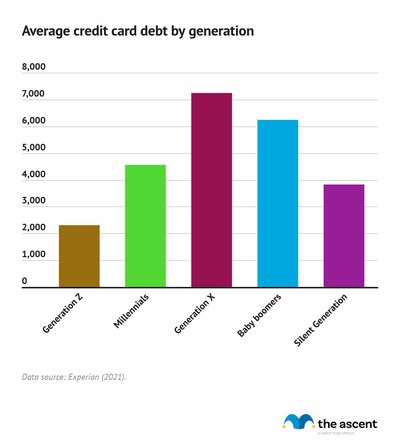
| Generation | Average credit card debt |
|---|---|
| Generation Z | $2,312 |
| Millennials | $4,569 |
| Generation X | $vii,236 |
| Infant Boomers | $6,230 |
| Silent Generation | $3,821 |
Information source: Experian (2021).
Average credit card debt for college students
College students have an average credit card debt of $i,183.
Considering students are frequently on a tight budget, their credit carte du jour balances are much lower than the average. Even though that's a good sign, a lower-than-average residue tin can still be difficult to pay off when you lot have a limited income.
| Year | Average credit carte debt, college students |
|---|---|
| 2016 | $903 |
| 2019 | $1,183 |
Data source: Sallie Mae (2019).
Boilerplate credit menu debt by income
Americans in higher income brackets acquit higher credit card balances on average.
Even so, it'southward the middle course and the upper-middle course that's more likely to take credit carte du jour debt. Among Americans in the 60th through 79th income percentiles, 56.8% have credit card debt. Those in the 40th through 59th income percentile weren't far behind, as 55% have credit card debt.
Information technology's the Americans in the highest (90th to 100th) and lowest (under 20th) income percentiles who are least probable to carry a balance. Less than a third of each grouping has credit carte debt.
| Income percentile | Median annual income | Average credit card debt | Percentage with credit bill of fare debt |
|---|---|---|---|
| Less than 20 | $xvi,290 | $iii,830 | 30.5% |
| 20–39 | $35,630 | $iv,650 | 45.6% |
| 40–59 | $59,050 | $4,910 | 55.0% |
| 60–79 | $95,700 | $6,990 | 56.eight% |
| 80–89 | $151,700 | $9,780 | 45.ix% |
| 90–100 | $290,160 | $12,600 | 32.two% |
Data source: Federal Reserve Survey of Consumer Finances (2020).
Editor'due south note: Data from the Survey of Consumer Finances was collected in 2019, and is the most contempo bachelor from the Federal Reserve.
Average credit menu debt by level of education
Average credit card debt is higher for Americans with higher levels of didactics.
Higher graduates accept the highest boilerplate credit card debt at $7,940. On the other hand, those with no high school diploma have $iii,390 in boilerplate credit card debt.
The most reasonable explanation for this is each group'south respective income. Median income increases at each level of education. As an example, Americans with a bachelor's caste earn over twice as much as Americans with no high schoolhouse diploma. Higher income, as nosotros saw earlier, corresponds to college credit card debt.
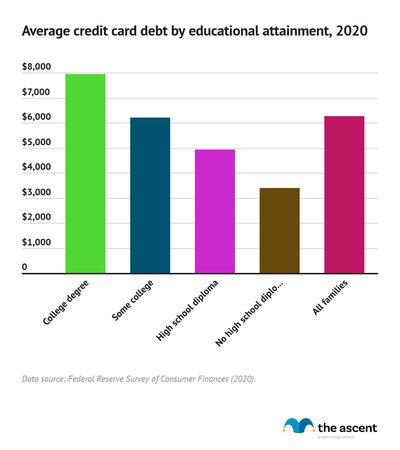
| Educational attainment | Average credit card debt |
|---|---|
| College degree | $seven,940 |
| Some higher | $six,210 |
| High school diploma | $iv,940 |
| No high school diploma | $iii,390 |
| All families | $6,270 |
Information source: Federal Reserve Survey of Consumer Finances (2020).
Boilerplate credit card debt by race
White Americans accept boilerplate credit card debt of $6,940, the most of whatsoever racial group.
Black Americans have the lowest average credit bill of fare debt at $3,940, and Hispanic Americans are right in between those ii other groups with $5,510 in boilerplate credit card debt.
| Race/ethnicity | Average credit menu debt |
|---|---|
| White, non-Hispanic | $half dozen,940 |
| Black, non-Hispanic | $3,940 |
| Hispanic | $v,510 |
| Other | $six,320 |
| All families | $half dozen,270 |
Data source: Federal Reserve Survey of Consumer Finances (2020).
Average credit card interest rates
The average credit carte du jour APR on interest-bearing accounts is 16.2%.
Interest-bearing accounts include all credit cards that charge involvement. Information technology excludes credit cards that aren't charging interest at that time, then 0% intro APR credit cards don't count until the introductory menstruation ends.
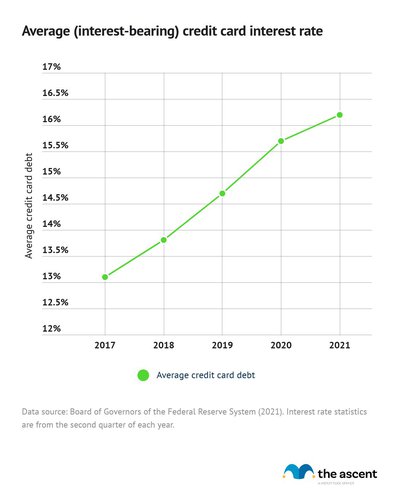
| Year | Average (interest-bearing) credit card interest rate |
|---|---|
| 2017 | 13.1% |
| 2018 | 13.8% |
| 2019 | 14.7% |
| 2020 | 15.vii% |
| 2021 | sixteen.two% |
Information source: Board of Governors of the Federal Reserve System (2021). Involvement rate statistics are from the second quarter of each year.
Credit card interest rates take been steadily increasing at a rate of nearly 0.8% per year since 2017. They slowed downwardly a chip this last year, when they grew by 0.5%.
Interest income makes up a pregnant chunk of credit carte du jour company earnings. It was 43% of the $176 billion credit bill of fare companies made in 2020.
Credit carte du jour delinquency rates
A credit carte account is considered delinquent when it'southward at least 30 days by due. Although that already does pregnant damage to the cardholder's credit score and carries financial penalties, the consequences get worse equally the card passes lx and xc days past due.
Credit bill of fare delinquency rates take fallen over the past two years. Delinquencies of ninety days or more have seen the best results, as they're downwardly 63%.
| Days past due | 2019 | 2020 | 2021 |
|---|---|---|---|
| 30–59 | 3.9% | 2.4% | ii.3% |
| lx–89 | 1.nine% | i.3% | i.0% |
| 90 or more | half-dozen.8% | 3.8% | ii.5% |
Data source: Experian (2020).
Credit card delinquency rates by generation
Millennials and Generation 10 have the highest credit menu malversation rates by a large margin in 2021. Members of the Silent Generation are the to the lowest degree likely to be delinquent on their credit cards.
| Generation | 30–59 days | sixty–89 days | 90 or more than days |
|---|---|---|---|
| Generation Z | ii.12% | 0.95% | i.73% |
| Millennials | 3.07% | one.32% | three.15% |
| Generation 10 | three.02% | i.25% | 3.42% |
| Baby Boomers | ane.80% | 0.77% | 2.05% |
| Silent Generation | 1.07% | 0.51% | i.33% |
Information source: Experian (2021).
Average credit utilization rate by age
The boilerplate credit utilization rate is 25.two%.
This metric, also known as a credit utilization ratio, is your credit card balances divided past your credit limits. If y'all take one credit carte du jour with a $1,000 balance and a $ten,000 credit limit, and then your credit utilization would exist ten%.
Lower credit utilization is amend for your credit score, and the conventional wisdom is that you should go on information technology beneath xxx%. Most generations manage that. While Gen Z, millennials, and Gen Ten all have averages of effectually 30%, the average credit utilization drops quite a bit for baby boomers and the Silent Generation.
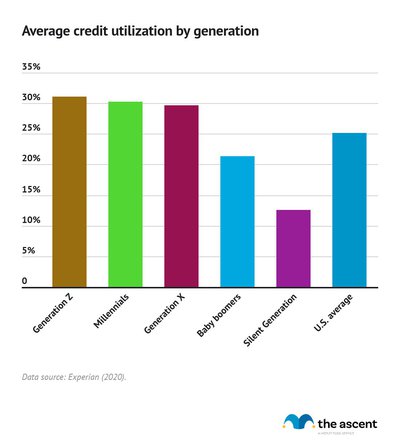
| Generation | Boilerplate credit utilization |
|---|---|
| Generation Z | 31.i% |
| Millennials | 30.2% |
| Generation 10 | 29.7% |
| Baby boomers | 21.4% |
| Silent Generation | 12.6% |
| U.S. Average | 25.2% |
Data source: Experian (2020).
How the COVID-19 pandemic affected credit bill of fare debt
Since the early stages of the COVID-19 pandemic, credit bill of fare balances take declined sharply. The boilerplate credit card remainder was nearly 13% lower in March 2021 than information technology was the year before, co-ordinate to a study past the Consumer Financial Protection Bureau.
The boilerplate credit card balance of $5,525 reported by Experian is a decrease of $968 from where it was prior to COVID-19.
Delinquency rates have also declined. The assistance programs that credit card companies offered during the pandemic may have played a part in helping cardholders avoid delinquencies. In April 2020, 2% of open credit card accounts started reporting assistance.
Most cardholders didn't need aid programs for long. Nigh 0.8% of credit card accounts transitioned out of aid in May 2020, and another 1.1% of accounts transitioned out in June 2020.
How to get out of credit card debt
As we've seen from these credit bill of fare debt statistics, owing money to credit card companies is a very mutual issue. Many Americans have expensive credit carte balances that are costing them interest every calendar month.
If you're in this state of affairs, here are some methods to consider that can assist you lot go out of credit carte du jour debt:
- Keep your credit carte charges to a minimum. Either don't use credit or only utilize it for necessary expenses so you don't add to your debt.
- Cut spending where y'all can. Look at your contempo spending, run into if there's anywhere y'all can cut dorsum, and make a budget that you tin use going forward. There are several budgeting apps that can help here. Put as much disposable income equally possible towards your credit card payments.
- Look into remainder transfer credit cards and debt consolidation loans. These are both fiscal tools that you can use to pay off debt. Balance transfer credit cards offer a 0% intro APR on credit carte du jour debt you lot transfer over. Debt consolidation loans typically have lower interest rates than most credit cards. They also have a fixed payment amount and length, which can provide the structure needed to eliminate credit card debt.
Sources
- Board of Governors of the Federal Reserve System (2021). "Commercial Banking concern Interest Rate on Credit Menu Plans, Accounts Assessed Interest-Federal Funds Effective Rate."
- Consumer Fiscal Protection Bureau (2021). "Credit card use is still declining compared to pre-pandemic levels."
- Consumer Financial Protection Agency (2020). "The Early on Furnishings of the COVID-19 Pandemic on Consumer Credit."
- Experian (2020). "Credit Card Debt in 2020: Balances Driblet for the First Time in Eight Years."
- Experian (2020). "State of Credit 2020."
- Experian (2021). "Land of Credit 2021."
- Federal Reserve Bank of New York (2021). "Quarterly Report on Household Debt and Credit."
- Federal Reserve Survey of Consumer Finances (2021). "2019 Survey of Consumer Finances (SCF)."
- Sallie Mae (2019). "Majoring in Money 2019."
Source: https://www.fool.com/the-ascent/research/credit-card-debt-statistics/
0 Response to "2018 How Much Credit Card Debt Do.most Families Carry"
Post a Comment